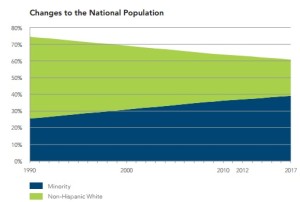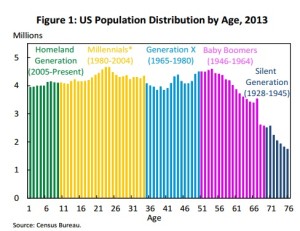For several years, we have witnessed a seismic demographic shift in the U.S. population in which people of color – Latinos, African-Americans, Asians and other ethnic groups – are becoming the majority. In 1990, non-Hispanic whites made up 74.5 percent of the population. In 2010, they dropped to 63.75 percent of the population and 63.03 in 2012. And, they are expected to decrease to 60.9 percent by 2017. The chart below displays the increase in minority populations from 1990 through 2017 as well as the decrease in population of non-Hispanic whites.
Source: http://www.esri.com/library/brochures/pdfs/minority-population-growth.pdf
Also, we note that millennials have become the majority demographic, in terms of age, as there are over 75 million totaling 25 percent of the U.S. population1. Not only do they have strength in numbers but also their buying power has reached 1.3 trillion dollars. 2
Source: U.S. Census Bureau
What does this mean for brands, advertisers and marketers? With these demographic changes, brands must tailor their marketing to effectively reach these multicultural consumers. And, advertising and marketing agencies must craft the messaging that the brands need. In this space, we’re going to delve into more statistics and insights on multicultural markets and look at some of the strategies brands can deploy in order to stay relevant to these consumers.
1 https://www.census.gov/newsroom/press-releases/2015/cb15-113.html
2 http://www.leadscon.com/18-statistics-that-marketers-need-to-know-about-millennials/


